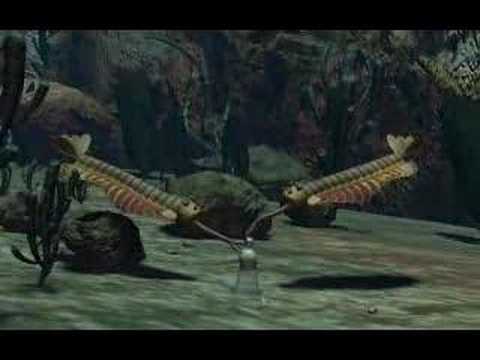12.5: The Cambrian Explosion
- Page ID
- 46222
Learning Outcomes
- Explain the significance of the Cambrian period for animal evolution and the changes in animal diversity that took place during that time
The Cambrian period, occurring between approximately 542–488 million years ago, marks the most rapid evolution of new animal phyla and animal diversity in Earth’s history. It is believed that most of the animal phyla in existence today had their origins during this time, often referred to as the Cambrian explosion. Echinoderms, mollusks, worms, arthropods, and chordates arose during this period. One of the most dominant species during the Cambrian period was the trilobite, an arthropod that was among the first animals to exhibit a sense of vision (Figure 1).

The cause of the Cambrian explosion is still debated. There are many theories that attempt to answer this question. Environmental changes may have created a more suitable environment for animal life. Examples of these changes include rising atmospheric oxygen levels and large increases in oceanic calcium concentrations that preceded the Cambrian period (Figure 2).

Some scientists believe that an expansive continental shelf with numerous shallow lagoons or pools provided the necessary living space for larger numbers of different types of animals to co-exist. There is also support for theories that argue that ecological relationships between species, such as changes in the food web, competition for food and space, and predator-prey relationships, were primed to promote a sudden massive coevolution of species. Yet other theories claim genetic and developmental reasons for the Cambrian explosion. The morphological flexibility and complexity of animal development afforded by the evolution of Hox control genes may have provided the necessary opportunities for increases in possible animal morphologies at the time of the Cambrian period. Theories that attempt to explain why the Cambrian explosion happened must be able to provide valid reasons for the massive animal diversification, as well as explain why it happened when it did. There is evidence that both supports and refutes each of the theories described above, and the answer may very well be a combination of these and other theories.
However, unresolved questions about the animal diversification that took place during the Cambrian period remain. For example, we do not understand how the evolution of so many species occurred in such a short period of time. Was there really an “explosion” of life at this particular time? Some scientists question the validity of the this idea, because there is increasing evidence to suggest that more animal life existed prior to the Cambrian period and that other similar species’ so-called explosions (or radiations) occurred later in history as well. Furthermore, the vast diversification of animal species that appears to have begun during the Cambrian period continued well into the following Ordovician period. Despite some of these arguments, most scientists agree that the Cambrian period marked a time of impressively rapid animal evolution and diversification that is unmatched elsewhere during history.
View an animation of what ocean life may have been like during the Cambrian explosion. Note that there isn’t any narration in the video.
Contributors and Attributions
- Biology. Provided by: OpenStax CNX. Located at: http://cnx.org/contents/185cbf87-c72e-48f5-b51e-f14f21b5eabd@10.8. License: CC BY: Attribution. License Terms: Download for free at http://cnx.org/contents/185cbf87-c72...f21b5eabd@10.8


